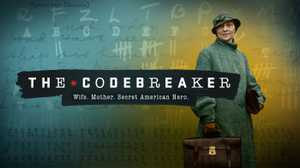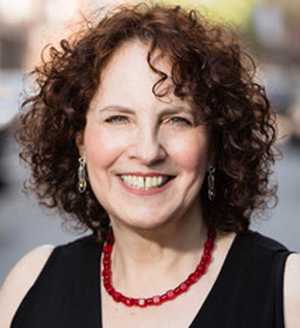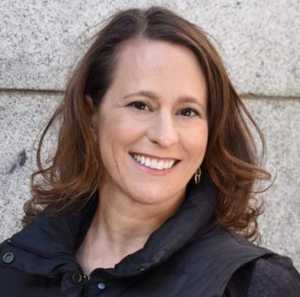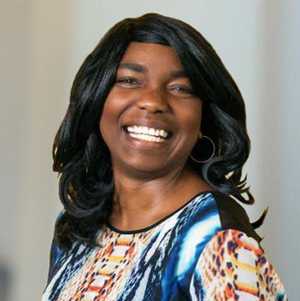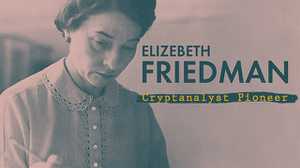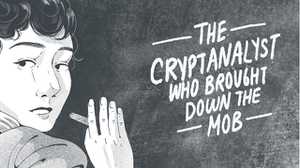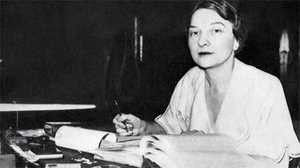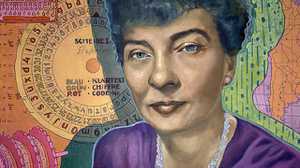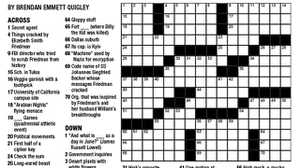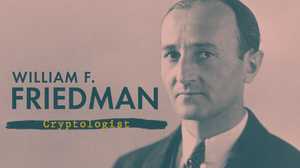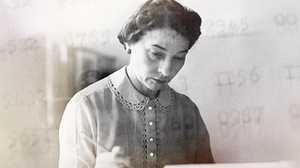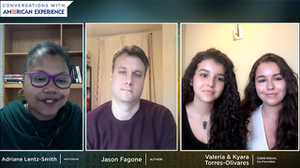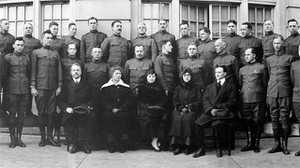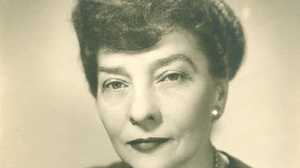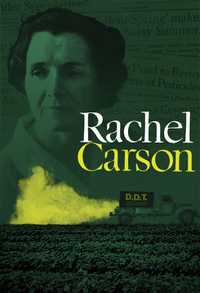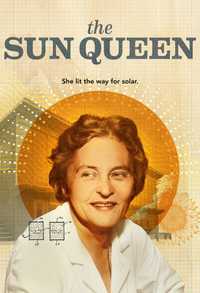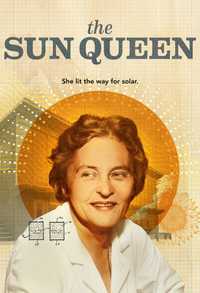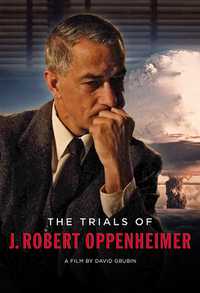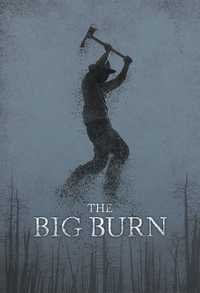Narration: In March of 1942 – German U-boats prowled the vast Atlantic ocean in wolf packs… attacking scores of Allied transport ships as they headed toward war-torn Europe. In less than three months, the Nazi submarines had sunk more than a million tons of desperately-needed supplies and killed thousands of soldiers.
The U-boat captains had a secret weapon -- encrypted messages sent by Nazi spies in South America had provided them with the coordinates of the targeted ships.
Rose Mary Sheldon, Historian: We’re talking about networks all over South America. An entire front in the second World War…
But America had on its side one of the most skilled codebreakers in the world – Elizebeth Friedman.
David Hatch, Senior Historian, NSA: She was a suburban mom. Nothing really to mark her as anything unusual. But, she lived a double life.
Narration: In WWI Friedman had trained the first team of codebreakers for the US military. During Prohibition she had taken on the most powerful gangsters in the country and brought down an international rum-running operation.
Barbara Osteika, Federal Law Enforcement Historian: The gangsters put a hit out on Elizebeth and the Coast Guard puts a protection detail on her…
Narration: Now, as she decrypted the intercepted messages on her desk, she knew everything she had learned in her career had led to this moment.
Amy Butler Greenfield, Writer: She was somebody who had the ability to see beyond what most other people could. She could see things starting to unlock in front of her eyes.
Narration: She was one woman fighting a secret army. Her success or failure could determine the outcome of the war.
Jason Fagone, Author, The Woman Who Smashed Codes: Elizebeth Friedman was a code-breaking, Quaker poet who hunted Nazi spies and there’s nobody like her then or since.
Narration: Elizebeth Smith Friedman’s life was unexpectedly set on course during a visit to the bustling city of Chicago in 1916. Twenty-three and full of dreams, she was hoping to escape the life she had been raised to expect.
Jason Fagone, Author, The Woman Who Smashed Codes: Elizebeth came from a large Quaker family in small town Indiana and from a very young age she felt like she didn’t fit in. She even hated her own name. She called it the odious name Smith. And she hated it because she believed that whenever she was introduced as Miss Smith she would be seen as something so ordinary and she didn’t want to be ordinary, she wanted to be extraordinary. She wanted an adventurous life.
Narration: Her mother, Sopha, had delivered ten children, the first when she was only seventeen. Elizebeth, born in 1892, was the youngest.
Jason Fagone, Author, The Woman Who Smashed Codes: Elizebeth often felt pity for her because Sopha’s life had been completely overtaken, it seemed to Elizebeth, by childbearing and child rearing. She didn’t seem to be able to pursue any kind of life of the mind, and to Elizebeth that was horrifying because Elizebeth was a very bookish kid. She loved to read, she loved poetry. She wrote her own poetry.
Amy Butler Greenfield, Writer: Her father was a Civil War veteran. He saw his youngest as a difficult child and their relationship absolutely was difficult. Her father did not support her going to college. He was against further education, particularly for women. She manages to talk him into this and he says she can have the money, but at 6% interest. She has to pay it all back.
Narration: In college, Elizebeth studied Greek and English literature. When she discovered Shakespeare, she became fascinated by the intricacies of language… sparking a passion that would drive her ambitions.
After graduation, Elizebeth pursued one of the few careers available to women at the time and accepted a teaching job at a small Indiana school. She found the work uninspiring, and quit after just a year.
In June of 1916, she headed for Chicago in search of a new job. After a week of effort, she found nothing.
With no income and no job prospects, Elizebeth had no choice but to return home in defeat.
On her last day in the city, she indulged in a visit to the Newberry Library to see a rare treasure – Shakespeare’s first folio, printed in 1623.
Jason Fagone, Author, The Woman Who Smashed Codes: She’s looking at this book of Shakespeare. And the librarian notices and says, “You’re interested in Shakespeare, aren’t you?” And Elizebeth says, “Well, yes.” And the librarian says, “You know, it’s funny, there’s an odd, wealthy man who keeps coming to the library… and he’s looking for somebody to help him with this project to find some kind of secret that he thinks is hidden in this book.
Narration: An hour later, George Fabyan was standing at her table. At six-foot-four, 250-pounds, the wealthy industrialist towered over her.
Jason Fagone, Author, The Woman Who Smashed Codes: He walks right up to Elizebeth and the first thing he says to her is, “Would you like to come out to Riverbank and spend the night with me?” She has no idea what to say to this. It’s the most indelicate question that anyone has ever posed to her.
Amy Butler Greenfield, Writer: And he grabs her under the elbow, lifts her up. She’s tiny, he’s huge. And he frog marches her out the door to a waiting limousine, which takes them to the railway station.
Narration: Soon, Elizebeth was wandering the grounds of Fabyan’s vast Riverbank estate, nestled on 350-acres of rolling hills in Geneva, Illinois.
Strolling the Japanese Garden, she was filled with a mix of astonishment and curiosity about the tycoon’s eccentric kingdom.
Jason Fagone, Author, The Woman Who Smashed Codes: George Fabyan had so much money that he could do essentially anything that he wanted. And what he wanted to do was to build a playground for science. He would go out and hire some of the leading scientists of the day, bring them to Riverbank, essentially collecting these scientists and he would set them loose and tell them to be spectacular. Tell them to make breakthroughs. Tell them to unlock the secrets of nature.
Narration: What captured most of Fabyan’s attention, however, was a literary project focused on proving that the works of William Shakespeare had been written by another author -- the Elizabethan philosopher and scientist, Francis Bacon.
Vince Houghton, Historian: Fabyan had the belief that William Shakespeare didn’t write Shakespeare. That actually Francis Bacon had written a code within the Shakespearean plays that demonstrated that Shakespeare was not the author, that Bacon actually was.
Narration: Fabyan assigned Elizebeth the job of ferreting out the secret message he believed Bacon had implanted in the text. Excited by the challenge, she first had to master a method of encoding messages invented by Francis Bacon in 1623.
In the Bacon system, each letter of the alphabet was assigned a combination of the letters A & B in groups of five.
Vince Houghton, Historian: Essentially what he did is he said, okay, I’m going to take every letter of the alphabet and break it down into a binary system of As and Bs. The letter A would turn into five As, A-A-A-A-A. The letter B was A-A-A-A-B. The letter C and so on. This can be represented any way you wanted to– as long as there are two different things you are using to represent the binary system.
Vince Houghton, Historian: And this is what the legend was, that the First Shakespeare Folio had this code written in two different typefaces throughout.
Narration: Once the differences in the typeface were identified, and the letters sorted into clusters of five, a hidden message would be revealed.
The work was tedious, but Elizebeth discovered she had the patience to stare at characters on a page for hours on end.
Jason Fagone, Author, The Woman Who Smashed Codes: What Elizebeth was required to do was peer through a magnifying glass and try to discern very subtle variations in the fonts on photographic enlargements of Shakespeare’s plays. And that was how she was going to break the code and rewrite the history of English literature.
Narration: Her work with the Shakespeare manuscripts would bring her together with the young man who was photographing and enlarging the Shakespeare texts, William Friedman. Genetics was his field of expertise. Photography was his hobby.
At Riverbank, he easily stood out.
Rose Mary Sheldon, Historian: William always wore a white starched shirt, which in that heat I don’t know how he didn’t perspire to death but he always looked very together, very cool. His hair was always combed perfectly. This was a man who knew how to dress.
Jason Fagone, Author, The Woman Who Smashed Codes: There are a lot of photos of just Elizebeth and you can tell that William is gazing down at his camera into the glass and seeing an image of her and probably smiling. She was unlike anyone he had ever met… he was very quickly falling in love.
Narration: The couple were an unlikely match – she was a Quaker from the Midwest and he was a Jewish immigrant from Russia.
David Hatch, Senior Historian, NSA: Late in his life, one of William Friedman’s colleagues asked him how he got into cryptology. According to the story, he had a sly smile on his face and he said, “I was seduced.”
Narration: Working across from each other day by day, they began digging into Fabyan’s collection of codebreaking books,1 exchanging insights and ideas.
Vince Houghton, Historian: And so Elizebeth was able to bring William into the fold and say, look, you can take your very mathematical, scientific approach to understanding codes and ciphers, I can bring my poetry and language skills and together we’ll be unstoppable.
Narration: As they began to master rudimentary skills, however, they saw little indication of embedded codes in the Shakespeare manuscripts.
Rose Mary Sheldon, Historian: Every now and then there will be a letter that is slightly different. Now, it could be just because the way the typeface struck the paper. There might be a little tail off a letter or a letter might be a little wider. They’re random marks and they can be made by any typesetter, especially back in the 16th century, and so they’re really rather meaningless…
Jason Fagone, Author, The Woman Who Smashed Codes: Now they both agreed that the central project at Riverbank had no scientific validity. It was all a pipe dream, it was a kind of delusion…
Narration: Disheartened by their revelation, they saw no future in codebreaking. Still, they saw a future with each other.
In May of 1917, Elizebeth and William stole away from Riverbank to get married in Chicago.
Jason Fagone, Author, The Woman Who Smashed Codes: William’s family was shocked and appalled by the marriage. They wanted to see him marry a Jewish woman. His brother later said that if William had been living in Pittsburgh at the time, in the close-knit Jewish community there, he would have been exiled.
Amy Butler Greenfield, Writer: The two of them go ahead and despite the differences in their background, despite the family opposition, despite the lack of money, despite all the many reasons why they should not get married, they do.
Narration: The newlyweds hoped to start a new life away from Riverbank.
World events, however, would upend their plans.
A month before they wed, the United States had entered the “Great War” in Europe—a war unlike anything that had come before—in part because of the invention of the radio.
Suddenly, the air was full of messages relaying information that could win or lose a battle, destroy a regiment, or sink a ship. All of it easily intercepted by anyone with an antenna.
Jason Fagone, Author, The Woman Who Smashed Codes: The invention of radio completely transformed the value of code breaking. So it put an incredible premium on cryptography, on strong codes and ciphers because now that those messages were flying through the air they had to be protected. The problem for America is that on the eve of World War I the United States was completely unprepared to break codes in the war.
Vince Houghton, Historian: The United States had no code breaking agency or bureau in the United States military. It just didn’t exist. There was no NSA, there was no CIA, the military branches had their own very, very small intelligence agencies, we’re talking about dozens of people not thousands in this case.
Narration: At Riverbank, George Fabyan saw an opportunity to serve his country – and to enhance his reputation. He established the first dedicated codebreaking unit in America2 and, much to their disbelief, placed Elizebeth and William in charge. Soon, the War, Navy, State, and Justice Departments were sending thousands of secret messages to Riverbank for decryption.3
Vince Houghton, Historian: So William and Elizebeth Friedman at this point hadn’t really done this systematically for very long. They’d kind of played with it a little bit. But all of a sudden, they’re being asked to break codes for the United States military in a world war. Talk about on the job training, this is as deep as on the job training gets.
Narration: The couple scrambled to expand their knowledge of codebreaking: starting with the most fundamental concepts like the difference between a cipher and a code.
Vince Houghton, Historian: A code is when you take a word or even a phrase and you replace it with another word or a phrase. So if we have the word “gun” we might say every place the word gun is, we’re going to put “Bob” instead. That way you’re able to replace the words, but if somebody intercepts your message, they may not actually know there’s a secret message there, because it reads like plain text. A cipher, on the other hand, is taking individual letters (or groups of letters) and changing them through some process, through some algorithm, into other letters, into numbers, into symbols, into anything, so that you can mix up the message and make it unreadable.
Narration: Using a method that had been around for hundreds of years, they began decrypting messages using frequency analysis.
Vince Houghton, Historian: This is what’s called a frequency chart. This is what allows a code breaker to very effectively look through an enciphered message and say okay, look, there’s a lot of Ns, there’s a lot of Gs, there are a lot of Qs, so the likelihood is those are going to be some of these very common letters in the English language. Es, Ts, Ns, As…If we understand this in a very mathematical way, it can help us to attack secret messages and break them down and understand what they actually mean.
Narration: Before long, though, William and Elizebeth reached the limits of what was known about codes and ciphers… and began inventing their own methods.
Jason Fagone: They figured out methods of solving secret messages that had never been imagined before… For the first eight months of World War I, this sounds incredible but it’s completely true, Elizebeth, William and their colleagues at Riverbank broke all messages for every part of the US military and the Department of Justice.
Narration: They documented their breakthroughs in eight volumes— known as the Riverbank Publications, which established a mathematical foundation to the principles of cryptology.
David Hatch, Senior Historian, NSA: Prior to the publications at Riverbank from Elizebeth and William, cryptology had been thought of as a field for linguists, for people with knowledge about foreign cultural areas and perhaps math might be a tool. But the Riverbank Laboratories publications turned cryptology from language to statistics.
Narration: In an age when codebreaking was becoming a weapon of war, Elizebeth and William were forging a new science4 of immense power.
It was a heady time for Elizebeth. She was training the first generation of codebreakers for the US military.
The couple were so captivated by cryptology, for fun they embedded codes everywhere5… even the officer trainee class photo.
As the group gathered, they instructed everyone assembled how to pose.
Vince Houghton, Historian: And if you’re just looking at the picture you’re like, man, whoever decided to shoot this wasn’t very disciplined. A good chunk of the people in the photograph are looking forward, but a good chunk are looking to the side.
Jason Fagone, Author, The Woman Who Smashed Codes: And it turns out that each person in the photo stands for a letter in Bacon’s biliteral cipher. So the people who are looking off to the side are the B form of the cipher and the people who are looking straight ahead are the A form.
Jason Fagone, Author, The Woman Who Smashed Codes: And when you put it all together the people in Bacon’s cipher spell out the phrase knowledge is power, which is one of Bacon’s mottos and a motto that William and Elizebeth adopted as their own. And it’s not written in letters but it’s written in people.
Narration: The Friedmans’ work at Riverbank was an eye-opener for the US military. Six months into the war, the Army established its own Cipher Bureau in Washington.
With the workload at Riverbank dwindling, William signed up for military duty as a field codebreaker in Europe.
Elizebeth wanted to do field work as well, but she could not; women were excluded from serving at the front.
Vince Houghton, Historian: Being left behind had to be incredibly difficult for Elizebeth. Not only is the man that she loves being sent off to fight a war, but this was her field. She taught William how to break codes and ciphers. This was a key way to move forward in your career. William could do it, she couldn’t.
Narration: And worse still, she would be on her own at Riverbank.
Jason Fagone, Author, The Woman Who Smashed Codes: It was a terrifying time for her. She let it be known in letters to William that George Fabyan was not treating her well, that he was pressuring her. There’s a reference in one of William’s letters to the fact that Fabyan might have sexually harassed Elizebeth, might have propositioned her. William was very angry, he called Fabyan that nameless rascal in that letter and said he wanted to hurt him, to beat him up. And so when they were reunited they were highly motivated to get the hell out of there.
Narration: At war’s end, William used his military contacts to line up a job in Washington.
He arrived in Washington with a reputation earned on the battlefield. Elizebeth arrived in Washington as William’s wife.
Technological innovations were fueling a global race to create evermore advanced devices for making and breaking codes. The post-war world was still a dangerous place. In 1921, William went to work for the Army Signal Corps developing new cipher machines.
Elizebeth was also offered a job – but at half of William’s salary. She took the position, but left after a year. She believed her codebreaking days were over.
Narration: In 1923, Elizebeth gave birth to a daughter. Soon followed by the birth of a son.
Codebreaking unexpectedly entered Elizebeth’s life again in 1925 when a Coast Guard officer knocked on the door of her suburban home with an urgent request. He explained that the Coast Guard’s network of radio towers had intercepted hundreds of encrypted messages but no one knew how to break them.
Decrypting the messages might help them gain the upper hand against a deadly adversary.
The Prohibition Act, signed into law several years earlier, had triggered an explosion of illegal trafficking in alcohol. Mobsters and gangsters ruled the streets.
Barbara Osteika: Murder was rampant and it became not just murder of gangster on gangster but they were starting to murder anybody who opposed them. The federal police didn’t even really understand the concept of organized crime.
Jason Fagone: A massive black market rises up and it’s controlled by gangsters, racketeers, and mafiosi. And very quickly they make a mockery out of the Coast Guard.
Narration: The Coast Guard was charged with stopping the deluge of liquor coming in by sea, but it only had 200 boats to patrol 5,000 miles of coastline. The rum runners, on the other hand, had unlimited resources. Huge ocean-going vessels served as mother ships that stored millions of dollars’ worth of liquor in their holds. A fleet of smaller crafts, called black ships, would divvy up the cargo and transport it back to shore. Logistics made possible by the use of shortwave radios and sophisticated codes.
The Coast Guard officer pleaded with Elizebeth for help. She was no teetotaler. But Elizebeth saw the damage organized crime was doing to the country.
During her first three months on the job, she single-handedly decrypted two years’ worth of backlogged messages.
Amy Butler Greenfield, Writer: It’s basically Elizebeth and a secretary filing her decrypts, and she’s doing all of that work during those years. She says she ends up looking at about 25,000 intercepts a year. That’s just astonishing. It’s really a war.
Narration: Elizebeth, however, was not just decrypting the messages… she was weaponizing the data she was gathering.
Barbara Osteika, Federal Law Enforcement Historian: What Elizebeth does is she begins the development of strategic intelligence, which nobody has done to this point. And what that means is she takes the information that she’s obtaining in these broken codes and ciphers, which are basically the plans and intentions of the gangsters… And she begins to figure out who owns the ships, where a ship is scheduled to leave from, where those ships are going, who’s meeting those ships. All of these arrangements were made with wireless radio.
Barbara Osteika, Federal Law Enforcement Historian: She was able to explain basically to the US government and all of its federal law enforcement agencies what organized crime looked like, how they were doing their job and how to stop them. And that is really visionary...
Narration: By 1931, Elizebeth’s work was so indispensable the Coast Guard approved her plan to build an official codebreaking unit -- one of only a handful of such units in the country and the first to be run by a woman.
Jason Fagone, Author, The Woman Who Smashed Codes: She was allowed to hire junior codebreakers and train them. She was given a raise to $3,800 a year, which is not a lot of money, but a bump for her. And she got a new title along with it, she was called the Cryptanalyst in Charge. Essentially the chief code breaker for the Coast Guard.
Narration: For a mother with young children, a home to run, and a husband who worked equally long hours -- it was an exhausting time.
A decade into Prohibition, the crime syndicates had grown into multinational businesses run with exacting efficiency. But with Elizebeth’s intelligence in tow, the US government could finally take the mobsters to court.
Elizebeth became the key witness in a series of sensational trials - starting with the prosecution of —CONEXCO—the largest rum running enterprise in the world.
Barbara Osteika: They had the network from the manufacturer of the liquor to the final distribution of that liquor to speakeasies and nightclubs. When the government went after CONEXCO it would be like the government going after Walmart today.
Narration: With a virtual monopoly on bootlegging in the Pacific and the Gulf of Mexico, CONEXCO supplied liquor to the most notorious mobster in the country, Al Capone.
Within a year, the US Government indicted CONEXCO’s top rank,6 which included Capone’s brother.
In 1933 at the trial in New Orleans, prosecutors called upon Elizebeth to testify against some of the most dangerous men in the country.
Barbara Osteika, Federal Law Enforcement Historian: There were a lot of prohibition agents who had already been killed in the line of duty.
Rose Mary Sheldon, Historian: There are these plain clothes people she doesn’t know – that are there to keep her from being whacked by the bad guys. But it wouldn’t have occurred to her not to testify against them. These people had to be put away, that was the whole point of breaking the codes.
Narration: When Elizebeth took the stand, she was grilled mercilessly by Al Capone’s attorney who worked to undermine her credibility.
Jason Fagone, Author, The Woman Who Smashed Codes: And whenever Elizebeth tried to explain how she solved the messages these six lawyers, men, would often stand up and object and say that it was some kind of witchcraft, that code breaking was not science, that Elizebeth was just making a guess.
Jason Fagone, Author, The Woman Who Smashed Codes: She got so fed up with the repeated objections of the defense attorneys that she asked a judge if she could have access to a blackboard. And Elizebeth proceeded to give a class in code breaking. And by the time she was finished the defense attorneys had nothing else to say.
Barbara Osteika, Federal Law Enforcement Historian: They must have been thinking they were going to be able to bowl her over and make her testimony irrelevant. And instead she takes control of that and, you know, seals the deal. She gets the conviction…
Narration: Elizebeth became a national celebrity. One newspaper headline praised her “Class in Cryptology.” Another described her as, “a pretty woman who protects the United States.” Reporters covering the trial expressed surprise that one woman could take down some of the most dangerous gangsters in the country.
Vince Houghton, Historian: This is juicy stuff, these are murderers and these are people who will become household names in America. And then along comes this woman who is the key witness at the trial to get these guys thrown in prison. They don’t talk about her skills, they don’t talk about her brains and her ability to break these codes and to bring these gangsters to justice. They talk about how she looks, how she’s dressed, that she’s this dainty, little woman who is bringing these big, Al Capone-type mobsters to justice.
Narration: William was delighted that his wife was finally getting the recognition she deserved. “I’m as proud as I can be,” he told her.
Narration: As Elizebeth’s work was seeing the light of day, William’s was burrowing deeper into the shadows.
By the late fall of 1939, Elizebeth knew something was terribly wrong with her husband.
Jason Fagone, Author, The Woman Who Smashed Codes: He developed mood swings, that’s what Elizebeth called them, mood swings or down swings. Elizebeth was trying to figure out what was going on. She assumed that he was working on a very difficult project at work. She didn’t know what it was. He didn’t tell her and he couldn’t tell her.
Narration: William’s work at the Army intelligence was classified top-secret. He was breaking into the encryption machines of America’s enemies.
The machines had reached a new level of complexity. Many were considered unbreakable.
With the start of the second world war in Europe, William’s work reached a new level of urgency.
Amy Butler Greenfield, Writer: There’s Blitzkrieg, you see Paris fall, you see that Britain is left standing almost alone. You see that the Japanese are starting to make overtures to be joined in alliance with Germany and with Italy. It’s looking very bad and William in addition as a Jewish man is aware that terrible things are happening to Jewish people in Germany. So I think the weight was colossal.
Narration: William was trying to pry open a Japanese machine called Purple – a device he had never seen or even had diagrams for.
Jason Fagone, Author, The Woman Who Smashed Codes: William and his team at the Army worked around the clock to try to reverse engineer these Japanese cipher machines because if they could then they would essentially be able to read the minds of the Axis powers– Japan and Nazi Germany.
Vince Houghton, Historian: William had to keep all that inside. He had a small group of people he worked with that he could talk to, but they all worked for him. And because he internalized all this stuff, it just burned him up inside until he finally broke.
Narration: William’s team finally cracked Purple in September of 1940. Three months later, he had a complete breakdown – and checked himself into the psychiatric unit of Walter Reed General Hospital.
Elizebeth watched in dismay as he sank deeper and deeper into a depression.
Jason Fagone, Author, The Woman Who Smashed Codes: William at that point was still the main breadwinner in the household. He made much more money than Elizebeth did. And so the fact of him being in the psych ward, the uncertainty about his future created a much bigger uncertainty about both of their lives.
Narration: Every day for the nearly three months he was hospitalized, Elizebeth made the exhausting trip to see her husband.
Amy Butler Greenfield, Writer: She is absolutely essential to William’s recovery. The medical establishment just let them sort it out themselves. And William says later that she was the person who sent down the rope to the terrible morass that he was in. She pulled him out of the swamp. She did it by willpower, she did it by faith in him.
Narration: After he was discharged, he returned to his job at the Army. But he would struggle with clinical depression for the rest of his life.
Jason Fagone, Author, The Woman Who Smashed Codes: Elizebeth and William had always been equals, a team. After William’s breakdown in 1941 he would never quite be the same. And so Elizebeth would have to step up. From now on she would in many ways have to be the stronger of the two.
Narration: In December 1941 – after a surprise Japanese attack at Pearl Harbor,8 the US military immediately ramped up its codebreaking capabilities.9
Elizebeth’s team had just shifted from the Coast Guard to the Navy. Now a military operation, the Navy placed a uniformed officer with much less experience in charge of the unit.
Rose Mary Sheldon, Historian: The Navy had a rule that women couldn’t be in charge of men and so she had to take a secondary position to a man who wasn’t as good as she was.
Jason Fagone, Author, The Woman Who Smashed Codes: She had to deal with the pain and the frustration of losing leadership of something that she had created, that she had built and that was really her baby.
Narration: The unit’s assignment was to monitor communications between a Nazi spy ring in South America and the German high command.
Amy Butler Greenfield, Writer: There had been a high amount of German emigration to South America in the early 20th century. There were places that had German towns with German street names, German newspapers, German schools. In addition, you had homegrown fascist movements. You had movements in Brazil, in Paraguay, and other countries where you see real similarities with what is going on with Hitler’s Germany and what’s happening in Mussolini’s Italy.
Narration: Decoding messages written in German wasn’t a problem for Elizebeth. She was now so skilled at recognizing the various statistical properties of foreign languages, a translator could do the rest.10 In her rum runner days she had even decrypted messages in Chinese.
Among the decrypted messages, one name appeared over and over: Sargo
Amy Butler Greenfield, Writer: She doesn’t know it yet but she’s starting to suspect she’s onto something big, and she is. Sargo is the code name for a man named Johannes Siegfried Becker. And Becker is the SS’s main man in South America. He is part of Hitler’s elite.
Narration: As Elizebeth began to decode Sargo’s messages, she made a startling revelation – his network was transmitting the locations of Allied ships to U-boats in the Atlantic.
Vince Houghton, Historian: One of the most important intelligence targets for the Germans is information about allied shipping… because it would be so easy for the Germans to pick off these supply ships one-by-one or to take out entire convoys all at once if they had accurate information about what route they were taking that they could knock the English out of the war. And without the English, the war’s essentially over.
Narration: In March of 1942, Elizebeth decrypted a series of ominous dispatches about the largest of the Allied supply ships, the Queen Mary.
March 8
Queen Mary departed on March 8 1800 local time
March 12
The Queen Mary on the 11th at 1800 MEZ was reported by the ship Campeiro
on the seas (near) Recife.
March 13
The Queen Mary on the 12th at 1500MEZ was reported near the coast of Ceara
Narration: With her record-breaking speed12 and size,13 the Queen Mary’s military value was so great -- Adolph Hitler was offering $250,000 to the U-boat captain who could bring her down.
On this trip more than 8,000 men stood to lose their lives if the ship was sunk.
Guided by the secret messages, the U-boats found the Queen Mary off the coast of Brazil.
But before they could strike, Elizebeth’s decrypts were relayed to the ship’s captain. He was able to take evasive maneuvers and bring the ship safely to port.
As soon as Elizebeth started unlocking Sargo’s messages, the balance in the Atlantic began to tip.
David Hatch, Senior Historian, NSA: The information could be given to American forces first for a ship to take evasive action, and also for the hunter killer teams that the Americans had in the South Atlantic. And many U-boats were sunk based on this kind of information. …
Vince Houghton, Historian: The work that Elizebeth Friedman is doing is some of the most important work of the second World War. It is allowing the supply line to exist.
Narration: Then, without warning, the Brazilian police started rounding up the Nazi spies. Within days, the airwaves went silent.
Vince Houghton, Historian: One of the worst things that you can do, if you’re chasing spies, is to arrest them before you’re done following them and watching them and seeing what they’re doing. Because the easiest way for a country to know that you’ve broken their communication system, or that they have a leak somewhere, is if you round up all their spies.
Narration: Elizebeth was stunned to learn that her work had been tripped up by one of her own… the Brazilians were conducting the arrests at the behest of the American FBI director —J. Edgar Hoover.
Vince Houghton, Historian: Hoover wants the glory, Hoover wants the headlines. That was really stupid of him to do. This is really life and death. Hoover is now completely cutting us off from this life saving intelligence that’s allowing us to keep our convoys safe in the Atlantic Ocean. This puts Elizebeth and her team back at square one.
Narration: Sargo escaped and immediately rebuilt the network. The spies set up 15 new circuits, each adopting a far more complex system of codes.
Month after month, the unsolved messages piled up. Elizebeth suspected that the codes were being generated by a highly complex machine called the “Enigma” — used by the German Intelligence Service.
There were several models of the enigma. The British were using a newly-invented decoding device to crack into the version used by the German military. The machine Elizebeth was facing was slightly less intricate – but not by much. Her tools were still only pencil and paper.
Day after day she waded through the messages.
After two months,she spotted a chink in the Enigma’s armor. She intercepted a cache of 28 messages all sent in the same key — a careless mistake made by the spies.
The breakthrough enabled her to make inroads into the machine’s system. She lined up the messages one below the other in a technique called solving “in depth.”
Vince Houghton, Historian: When you solve in depth and you put your papers next to each other or one on top of the other and you’re looking at what is the first letter in each of these messages, what is the second letter in each of these messages… Once you have the knowledge that you’re dealing with the same key everyday, then you can actually start breaking down words and understanding what letters are turning into others…
Amy Butler Greenfield, Writer: I think that Elizebeth would be the first to say that you are always looking for the mistake that the other side is making. You find a little doorway that’s been left open just a smidge and that’s where you attack and that’s where you go in.
Narration: Finally, she was able to follow Sargo’s activities again.
The decrypted messages laid bare ominous new developments in South America.
Amy Butler Greenfield, Writer: There is a coup in Argentina, a fascist coup, in the summer of 1943. At the end of that Sargo is really on the inside… In Bolivia, again, he is working with people who want to turn the government toward the Nazis, and in December of 1943, lo and behold there’s a fascist coup in Bolivia. And this is scary stuff for the United States.
Vince Houghton, Historian: The fear is that the Germans will start a front in South America. This could be a dramatic game changer that could make it very difficult for us to fight the war overseas, because we’d be worried about fighting the war at home.
Narration: From her tiny office in Washington, Elizebeth shadowed Sargo’s every move. Any which way they turned, his spies were outflanked.
Vince Houghton, Historian: In the end Elizebeth is able to give information to the Allies which allows them to break up the spy ring and do it in such a way that the Germans have no idea that the spy ring was broken up because their codes had been broken.
Narration: German backed revolutions in Bolivia and Chile were crushed. Argentina’s relationship with Germany splintered.19 Within months, the Nazi threat in the Western Hemisphere was eliminated.
Sargo went into hiding. He would never rebuild his network again.
Elizabeth’s work in South America was an astonishing testament to the power of codebreaking.20 But it would be a private and lonely victory. She had signed a Navy oath promising her silence until death. She could tell no one. Not even William.
And she could do nothing as J. Edgar Hoover took credit for her crowning achievement.
He took all the decrypts she had sent him – all 4,000 of them -- and had them stamped with FBI identification numbers, erasing Elizebeth and her team from the official record.
Jason Fagone, Author, The Woman Who Smashed Codes: Elizebeth just had to kind of grin and bear it, and after a while she wasn’t grinning so much anymore. It kind of ate at her, but there was very little that she could do.
Narration: In her Christmas card in 1944, she wrote friends that she was just carrying on a routine Navy job. William added a PS: “Elizebeth was, is, and continues to be the most fascinating woman I’ve ever known.”
WWII ended in August, 1945. A year later, Elizebeth’s unit was disbanded.21 She was 54 years old and out of a job.
Codebreaking by pencil and paper had become a thing of the past. Computers were the future.22
Amy Butler Greenfield, Writer: The post-war era will be like nothing Elizebeth has ever seen, and she knows that. She knows it’s changing. She can see that her era is ending.
Narration: William continued to work for the government. In the early 1950s he suffered a series of heart attacks and continued to struggle with mental illness.
Jason Fagone, Author, The Woman Who Smashed Codes: He was so depressed that he was unable to even start his hand to move on a pad of paper at the office, and so Elizebeth would put her hand on top of his and move the pencil for him. And in that way he was able to begin to work, begin to draw, begin to think and come to life… To me, that says everything about the Friedmans, who they were, their bond.
Narration: William died of a heart attack on November 2, 1969.
Though Elizebeth’s career as a codebreaker was long over, codebreaking itself was becoming a critical part of keeping the nation safe.
The US government had created the National Security Agency – the NSA – in 1952, and charged it with collecting cryptographic communications and strengthening the nation’s codes. It would become the largest, most secretive and far-reaching arm of US intelligence gathering.
Vince Houghton, Historian: Even though we’re not fighting a shooting war, we are keeping secrets, and a lot of them, and not letting the American public know what the government is doing in its name. Elizebeth felt that it was going too far,too far, collecting too much information, becoming too intrusive, violating too much privacy. Some of the same themes that will basically pester the NSA for the next several decades.
Narration: Even as intelligence gathering grew into something Elizebeth would hardly recognize, her methods formed the basis of codebreaking for decades to come.
Jason Fagone, Author, The Woman Who Smashed Codes: She helped to create an immensely powerful new science of code breaking... And so there’s still a good portion of her DNA in codebreaking today, even though it’s been mathematized and done on computers. She laid a foundation for what happens at American intelligence agencies everyday today.
Narration: Elizebeth struggled in her final years as her savings dried up. She died on October 31, 1980 in a nursing home in New Jersey. She took her secret life to the grave.
The government kept the files detailing Elizebeth Friedman’s history making work locked away for 62 years. In 2008, decades after her death, they were finally declassified.
Amy Butler Greenfield, Writer: If we could miss something as big as Elizebeth, who is crucial in two world wars, who fights crime, who fights the mob, if we missed her, who else are we missing?
